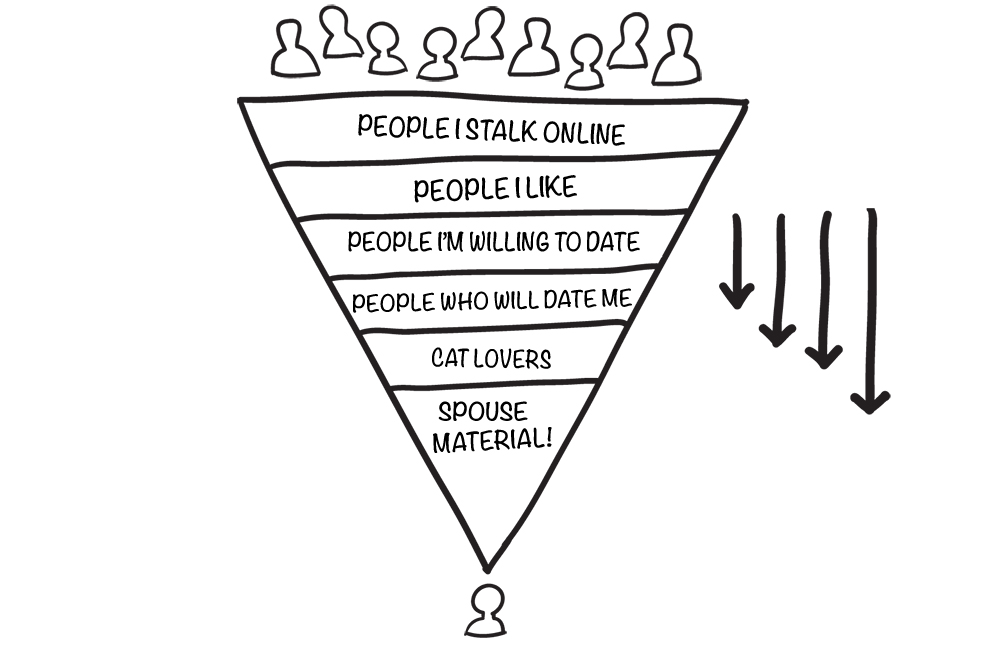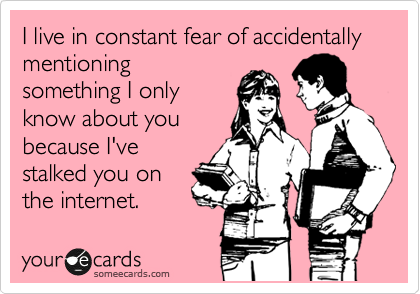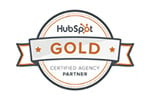There’s something comforting about the traditional sales funnel stages for B2B salespeople and marketers. You know that if you toss a certain number of leads in at the top, you can expect a (small) percentage of deals to shake out at the bottom.
It’s just like lining up tons of online dates hoping to find ‘The One’.

I think I have some pipeline problems…
However, the good ol’ sales funnel isn’t holding up as well as it used to.
Buyers (and daters) are more empowered by choice and technology—which makes them more skeptical (and picky) than ever before. Over two-thirds of buyers wait longer to contact vendors than they did a few years ago because they’re doing more of their own research.
The reason? They’re scared to make a wrong decision. No one wants to waste time and resources, especially if it means losing their job (or getting dumped—not sure which is worse). And, in these digitally-connected days, there’s no excuse for not doing in-depth vendor research.

Let’s hope the next person you date NEVER sees your search history.
All of this means your sales funnel stages (or dating pipeline) is a minefield of potential relationship killers and exit points.

Is this seriously the best email nurture you could write? I’m done.
Read on to learn why and where your prospects are dropping out of your pipeline, and how to prevent them from straying. (Consider the dating advice a free bonus!)
1) Flirting: the awareness stage
Getting someone’s attention in a crowd can be tough, no matter how tight your value prop is.
Unless you’re this person:

No one can resist gold lamé. It’s a fact.
It doesn’t matter what your reps or marketing messages say; prospects don’t trust them. If buyers haven’t heard of your product or talked to someone who has used your product, they won’t feel comfortable giving you their contact info or answering a cold call.
How to get their digits: Don’t be an unknown to your prospects. This doesn’t mean plastering your logo everywhere or posting more from your corporate social media accounts.
Get some mutual friends to intervene on your behalf: your brand advocates. If you uncover these super fans, and treat them right, their genuine enthusiasm and product expertise will ease your prospects’ buyer doubt at every stage in the sales funnel.
Incentivize your advocates to make introductions to their peers—who likely have potential matches for your brand in their Rolodexes. Starting a referral program, or running a referral contest, can help you kickstart the process. The key is making sure you thank your advocates in an appropriate way for making an introduction—especially if it turns into new business.
2) Dating: the interest stage
So buyers have heard your name. Big deal. They’ve still got lots of choice, and they will string you along until they’ve made a decision.

Why is love—and B2B sales—so cruel?
While you may have potential to make the vendor shortlist, they need to know that you can deliver on your promises. And it’s going to take more than a few case studies to make that happen, especially if they want their friends’—err, I mean coworkers’—approval before they make a choice.
You need to surround your prospects (and all key decision makers) with social proof from people they trust. It’s even more powerful when it comes from channels you don’t own. A hand-picked testimonial on your website isn’t enough.
Courting your prospects: Make sure your online reputation on 3rd-party resources—like review sites, industry forums and social media—is pristine. If prospects only find negative comments—or nothing at all—in these places, they’ll suddenly become really busy, you know, because work is so hectic right now, and they just aren’t sure what they want anymore…
To present yourself as a safe bet, encourage your customer advocates to write genuine reviews when they’ve reached a certain level of expertise with your product. You can also direct them to discussion threads about your product or industry where they can showcase their knowledge.
If you position the request as a chance to boost their professional profile, they’ll be appreciative. Make sure to internally and externally recognize them for their help. Feature their comments in a newsletter, blog or a thank you tweet to keep the buzz going.
3) Ready to commit: the decision stage
What happens when a buyer is ready to seal the deal, but can’t find a good reference to confirm your sales rep’s promises right away? They get spooked.

My mom is very objective. Plus, her raisin muffins are THE BEST!
The problem with references is prospects often demand to talk to *really* specific ones. It can take your team days to search Salesforce for a senior manager in an identical vertical at a company with a similar team size, business model, revenue level and location. Oh, and who is really happy with your product/service right now.
Sealing the deal: Most reference programs don’t help you continually (and easily) uncover new, relevant customers for your prospects to talk to. They also don’t prepare customers to be superb references. If you want to make sure you can quickly turn around reference requests, you need to do a few things:
- Have a way to continually invite and uncover new references so you don’t burn out the handful of customers you always turn to
- Make reference requests a volunteer opportunity, and position them as a chance to network with others
- Continually engage and educate references so they can easily and happily discuss your product
This means setting up new systems for grooming references and making sure the process is valuable for everyone involved.
4) Marriage: the retention stage
What happens after your prospects say “I do”? Usually, this is the moment sales and marketing disappear. That’s a shame, because oftentimes, a buyer’s anxiety kicks in soon after that new signing glow fades—especially if on-boarding doesn’t go smoothly.
Now, all the promises made during the buying process are left to the customer success and support teams to fulfill.

“Aaaaand half of the features in this contract aren’t out of beta…”
Retention is the most ignored stage of the sales funnel. If you aren’t actively engaging new customers from Day 1, their insecurity will grow. Then, by the time contract renewal rolls around, they’ll churn.
More importantly, these neglected customers won’t help fuel your sales funnel stages by advocating for you.
Keeping the honeymoon phase alive: Make sure you’re regularly educating your advocates and helping them build connections with your team and each other. You can do this by building an online community and hosting local meet-ups. If you give your advocates personal connections and opportunities to grow, they’ll be more inclined to stick around and become vocal champions for your brand.


